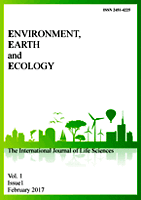| 1. |
Caron J, and Rochefort L (2013) Use of peat in growing media: state of the art on industrial and 102 scientific effort envisioning sustainability. Acta Hort. 982:15–22.
|
| 2. |
Chan KY, Xu Z (2009) Biochar: Nutrient Properties and Their Enhancement. Biochar for environmental management: science and technology, 1, 67-84.
|
| 3. |
Cheng CH, Lehmann J, Thies JE, Burton SD, Engelhard, MH (2008) Oxidation of black carbon by biotic and abiotic processes. Org. Geochem., 37: 1477–1488.
|
| 4. |
Dumroese RK, Heiskanen J, Englund K, Tervahauta A (2011) Pelleted biochar: 138 Chemical and physical properties show potential use as a substrate in container nurseries. 139 Biomass and Bioenerg. 35(5):2018–2027.
|
| 5. |
Handreck K, Black N (1999) Growing Media for Ornamental Plants and Turf, University of South Wales Press, pp 111-129.
|
| 6. |
Hartmann HT, Kester DE Jr, Davies FT, Geneve RL (2002) Plant Propagation, Principles and Practices, 7th Edition, Prentice Hall, Upper Saddle River, New Jersey. P 880.
|
| 7. |
http://www.independent.co.uk/e...- global-warming-1055700.html. Accessed on 19th December, 2016.
|
| 8. |
Idun IA, Kumah P, Adzraku HV (2011) Rooting and vegetative growth responses of difficult-to-root Ixora coccinea and Ficus benjamina cv. starlight to different stem cutting types and soilless media. African Journal of Plant Science, 5(13), 773-780.
|
| 9. |
Ioannidou O, Zabaniotou A (2007) Agricultural residues as precursors for activated carbon production—a review. Renewable and Sustainable Energy Reviews, 11(9), 1966-2005.
|
| 10. |
Lean G (2008) "Ancient Skills 'Could Reverse Global Warming'", The Independent, http://www.independent.co.uk/e.... [Accessed: 19th October, 2016].
|
| 11. |
Lehmann J, da Silva JP, Steiner C, Nehls T, Zech W, Glaser B (2003) Nutrient availability and leaching in an archaeological anthrosol and a ferralsol of the central amazon basin: Fertilizer, manure and charcoal amendments. Plant Soil 2003, 249, 343–357.
|
| 12. |
Leonard P (2012) pH for the garden, University of Vermont Extension Department of Plant and Soil Science website, accessed on 8th May, 2017.
|
| 13. |
Liang B, Lehmann J, Solomon D, Kinyangi J, Grossman J, O’Neill B, Skjemstad JO, Thies J, Luizao FJ, Petersen J, Neves EG (2006) Black Carbon Increases Cation Exchange Capacity in Soils, Soil Science Society of America Journal 70:1719–1730.
|
| 14. |
Lopez RG, Runkle ES (2008) Photosynthetic daily light integral during propagation influences rooting and growth of cuttings and subsequent development of New Guinea impatiens and petunia. HortScience, 43(7), 2052-2059.
|
| 15. |
Nigussie A, Kissi E, Misganaw M, Ambaw G (2012) Effect of Biochar Application on Soil Properties and Nutrient Uptake of Lettuces (Lactuca sativa) Grown in Chromium Polluted Soils, American-Eurasian. Journal of Agricultural and Environmental Science 12 (3): 369-376, 2012, ISSN 1818-6769, IDOSI Publications.
|
| 16. |
Northup JI (2013) Biochar as a replacement for perlite in greenhouse soilless substrates. Iowa 276 State Univ. Ames, IA, M.S. Thesis. 65-13399.
|
| 17. |
Ogundele AT, Eludoyin OS, Oladapo OS (2011) Assessment of Impacts of Charcoal Production on Soil Properties in the Derived Savanna, Oyo state, Nigeria. Journal of Soil Science and Environmental Management 2: 142-146.
|
| 18. |
Reddy KR, Xie T, Dastgheibi S (2014) Evaluation of biochar as a potential filter media for the removal of mixed contaminants from urban storm water runoff. Journal of Environmental Engineering, 140(12), 04014043.
|
| 19. |
Steiner C, Harttung T (2014) Biochar as growing media additive and peat substitute. Solid 322 Earth Discussions, 6(1):1023–1035.
|
| 20. |
Van Zweiten L, Kimber S, Downie A, Morris S, Petty S, Rust J, Chan KY (2010) A glasshouse study on the interaction of low mineral as biochar with nitrogen In A Sandy Soil. Australian Journal of Soil Research 48, 569-576.
|
| 21. |
Yanai Y, Toyota K, Okazaki M (2007) Effects of charcoal addition on N₂O emission from soil from rewetting air-dried soil in short-term laboratory experiments. Soil Sci Plant Nutr 53:181-188.
|







